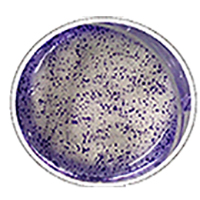Overexpression of MYBL2 predicts poor prognosis and promotes oncogenesis in endometrial carcinoma

Submitted: 7 February 2021
Accepted: 20 March 2021
Published: 30 March 2021
Accepted: 20 March 2021
Abstract Views: 1140
PDF: 616
Supplementary: 153
HTML: 9
Supplementary: 153
HTML: 9
Publisher's note
All claims expressed in this article are solely those of the authors and do not necessarily represent those of their affiliated organizations, or those of the publisher, the editors and the reviewers. Any product that may be evaluated in this article or claim that may be made by its manufacturer is not guaranteed or endorsed by the publisher.
All claims expressed in this article are solely those of the authors and do not necessarily represent those of their affiliated organizations, or those of the publisher, the editors and the reviewers. Any product that may be evaluated in this article or claim that may be made by its manufacturer is not guaranteed or endorsed by the publisher.
Similar Articles
- Y Hori, S Sato, J Yamate, M Kurasaki, Immunohistochemical study of macrophage migration inhibitory factor in rat liver fibrosis induced by thioacetamide , European Journal of Histochemistry: Vol. 47 No. 4 (2003)
- V. Matozzo, M. G. Marin, First cytochemical study of haemocytes from the crab Carcinus aestuarii (Crustacea, Decapoda) , European Journal of Histochemistry: Vol. 54 No. 1 (2010)
- D Cavallo, R De Vita, P Eleuteri, L Borkin, V Ermechenko, G Odierna, E Balletto, Karyological and flow cytometric evidence of triploid specimens in Bufo viridis (Amphibia Anura) , European Journal of Histochemistry: Vol. 46 No. 2 (2002)
- S. He, J. Yang, Maturation of neurotransmission in the developing rat cochlea: immunohistochemical evidence from differential expression of synaptophysin and synaptobrevin 2 , European Journal of Histochemistry: Vol. 55 No. 1 (2011)
- C. Dall'Oca, T. Maluta, F. Cavani, G.P. Morbioli, P. Bernardi, A. Sbarbati, D. Degl'Innocenti, B. Magnan, The biocompatibility of porous vs non-porous bone cements: a new methodological approach , European Journal of Histochemistry: Vol. 58 No. 2 (2014)
- C Lanni, MG Bottone, A Bardoni, K Dyne, Proliferation characteristics and polyploidization of cultured myofibroblasts from a patient with fibroblastic rheumatism , European Journal of Histochemistry: Vol. 47 No. 3 (2003)
- G Lai, S Nemolato, S Lecca, G Parodo, C Medda, G Faa, The role of immunohistochemistry in the diagnosis of hyalinizing clear cell carcinoma of the minor salivary gland: a case report , European Journal of Histochemistry: Vol. 52 No. 4 (2008)
- G. Di Guardo, Lipofuscin, lipofuscin-like pigments and autofluorescence , European Journal of Histochemistry: Vol. 59 No. 1 (2015)
- A Franchini, E Marchesini, R Poletti, E Ottaviania, Swiss mice CD1 fed on mussels contaminated by okadaic acid and yessotoxins: effects on thymus and spleen , European Journal of Histochemistry: Vol. 49 No. 2 (2005)
- G Giuffrè, V Barresi, A Catalano, A Cappiello, F Stagno d’Alcontres, G Tuccari, Actinic keratosis associated with squamous and basal cell carcinomas: an evaluation of neoplastic progression by a standardized AgNOR analysis , European Journal of Histochemistry: Vol. 52 No. 1 (2008)
<< < 42 43 44 45 46 47 48 49 50 51 > >>
You may also start an advanced similarity search for this article.

 https://doi.org/10.4081/ejh.2021.3226
https://doi.org/10.4081/ejh.2021.3226










